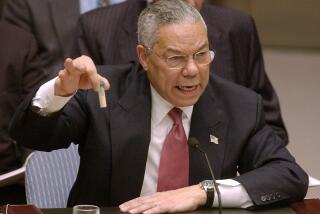Bush’s First Battle: His Own Military Myths
NEW YORK — His campaign rhetoric notwithstanding, President George W. Bush has taken a good first step by not increasing the defense budget he inherited from President Bill Clinton until he completes a top-down review of strategy. Such a review will come to naught, however, if the new president does not reject the six oversimplifications about the state of our armed forces that he embraced repeatedly during the campaign.
* Military people are not overworked and underpaid and, despite campaign rhetoric, most aren’t on food stamps. During the 1990s, an average of 40,000 military people were deployed in various “operations other than war.” This represents less than 3% of the active force and less than 2% of the total force, counting reserves. A greater percentage of the active force was stationed in the United States than during the 1980s. Certain units like Army civil affairs battalions, which help restore order in foreign countries torn apart by civil wars, or Air Force search and rescue units were over-utilized. But that is a management problem, not a revenue problem. As for pay, most men and women in the armed services make more than 75% of their civilian counterparts. And, if the compensation levels of military people were adjusted to reflect the fair market value of their housing allowances, fewer than 1% would be eligible for food stamps.
The problem is that the military still uses an anachronistic “one size fits all” pay system that rewards longevity rather than performance. Also, the military employs a deferred-benefit retirement system that costs twice as much as a deferred-contribution plan, while providing the wrong incentives for retaining the right people for the appropriate length of time. For example, to justify the training investment, pilots need to be retained for 13 years, but infantrymen only five. Yet, no military person is vested in retirement until he or she serves 20 years.
* The military does not need to be rebuilt; it needs to be transformed. In the 1990s, the Pentagon invested more than $1 trillion in developing and procuring new weapons. But much of it was wasted on Cold War relics--$200-million fighter planes, $6-billion aircraft carriers, $2-billion submarines, $400-million artillery pieces--that will be of little use in the conflicts of the 21st century.
* The military is more than prepared to fight two wars. In fact, it is becoming more prepared each day as the military power of the likely opponents in these two conflicts, Iraq and North Korea, dwindles. Yet, while the capability of these states declines, the Pentagon has been increasing its estimates of the forces necessary to defeat these enemies. Moreover, the necessity of maintaining the capability to fight two wars simultaneously defies logic and history. During the Korea, Vietnam and Persian Gulf conflicts, no other nation took advantage of the situation by threatening U.S. interests elsewhere.
* Calculating the size of the defense budget by measuring it against the gross domestic product is nonsensical. Yes, the U.S. spends a smaller portion of GDP on defense than it did during the Cold War, but the U.S. economy has grown substantially since the collapse of the Soviet Union while spending by adversaries has markedly declined. Even counting inflation, the $325-billion defense budget--which includes the military portion of the Energy Department budget--that Bush inherits from Clinton is about 95% of what this nation spent on average to win the Cold War. In fact, the last Clinton defense budget is higher than the budget that Defense Secretary Donald H. Rumsfeld prepared for the outgoing Ford administration 25 years ago, at the height of the Cold War.
* Carrying out peacekeeping missions, like Bosnia and Kosovo, is not undermining readiness. During the 1990s, peacekeeping operations accounted for less than 2% of Pentagon spending, and readiness spending per capita was more than 10% higher in the 1990s than in the 1980s.
* In order to meet their recruiting goals, the armed forces have not lowered their quality standards below those of the Reagan years. The force that Bush inherits from Clinton has a higher percentage of quality recruits--that is, high school graduates and individuals scoring average or above on the armed forces’ qualification test--than at any time during the Reagan years. Most of the retention problems that the services are having are self-inflicted. For example, 80% of the pilot shortage in the Navy and Air Force is caused by the fact that, in the early 1990s, the military made a serious mistake by reducing the number of pilots it trained. Likewise, the shortage of people on Navy ships is because the people are not in the right place.
If Bush and his national security team abandon these myths, they will have a much better chance of developing a coherent defense program--and may even be able to cut defense spending to an appropriate level.
More to Read
Sign up for Essential California
The most important California stories and recommendations in your inbox every morning.
You may occasionally receive promotional content from the Los Angeles Times.










